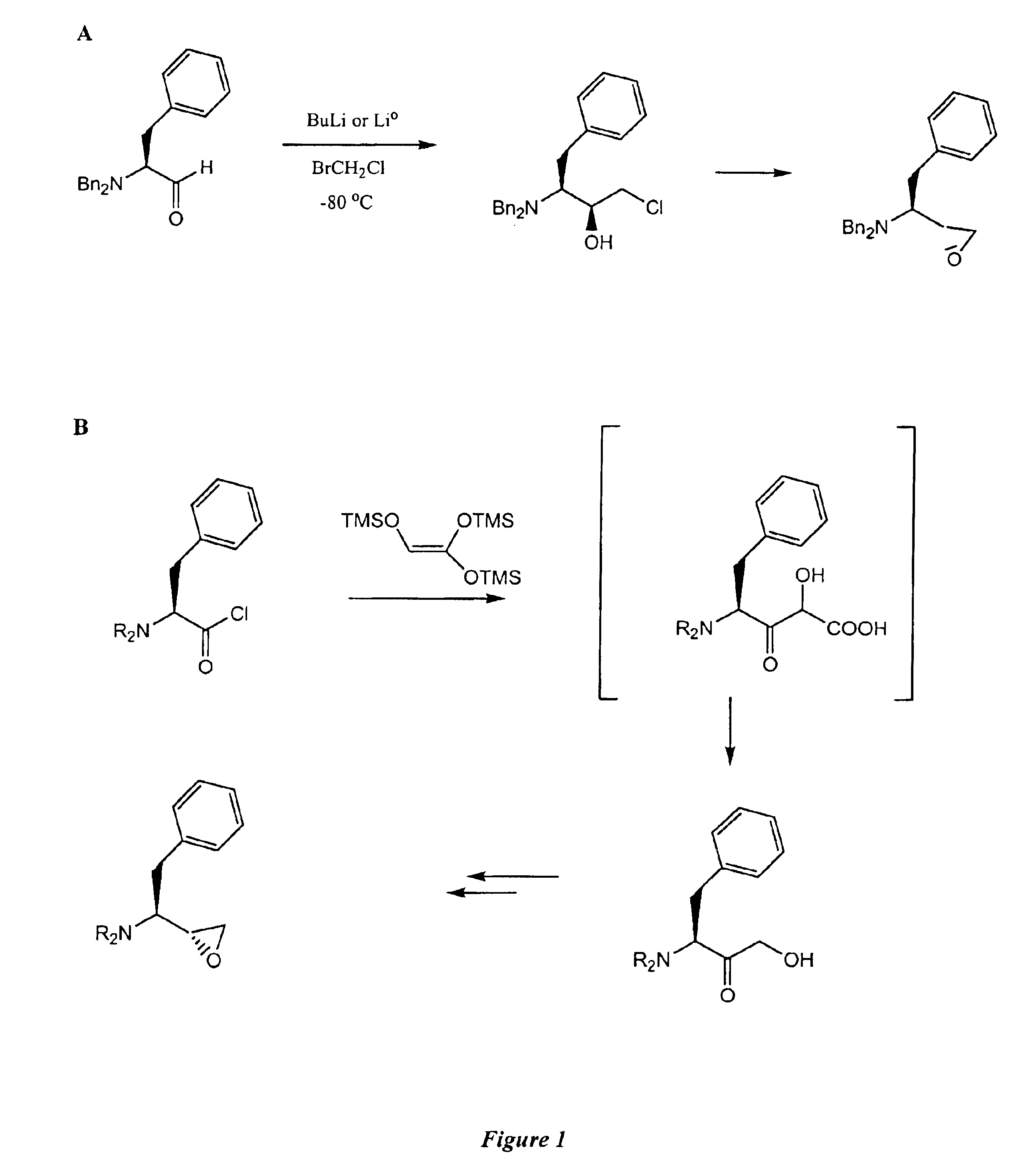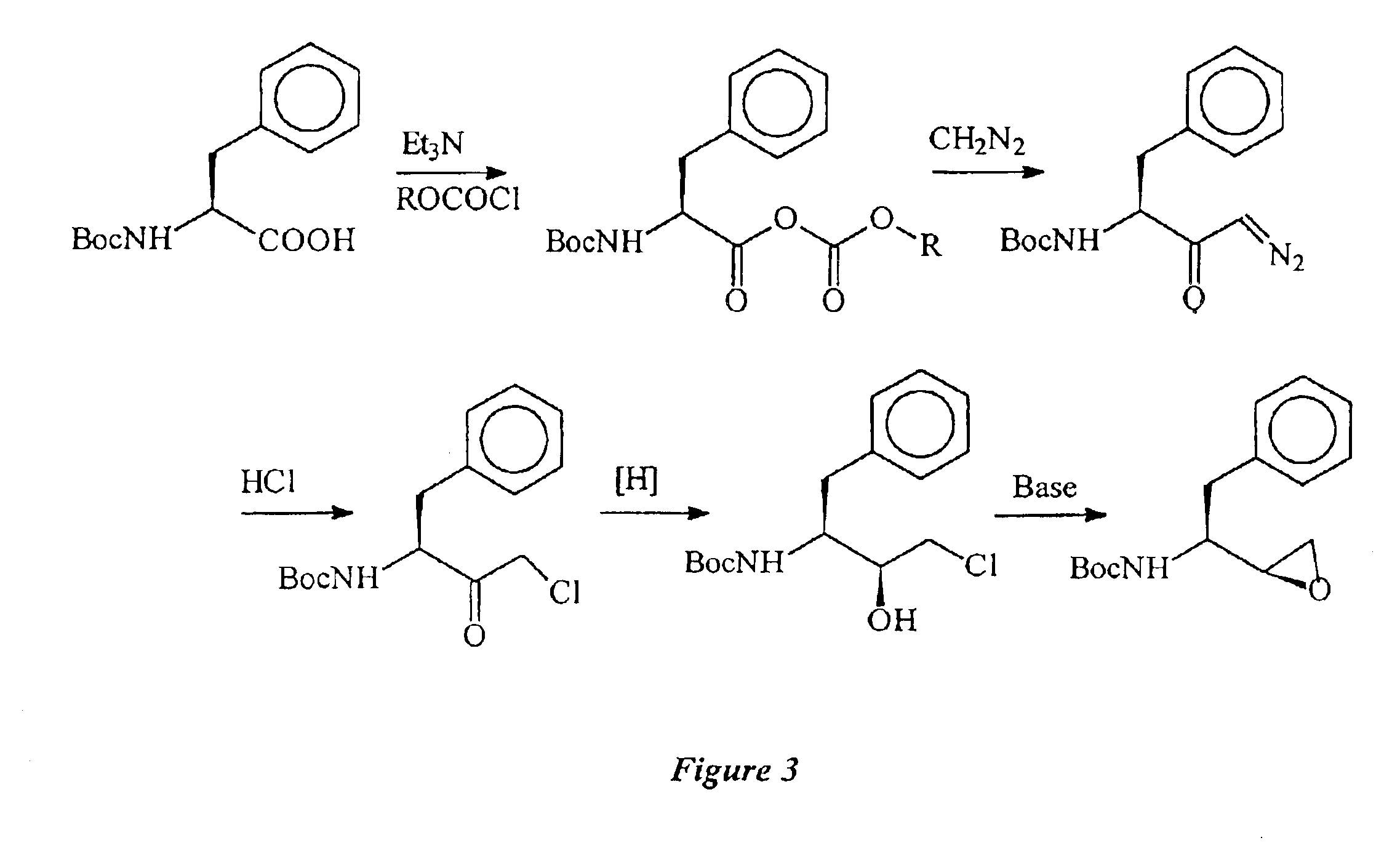Clean, high-yield preparation of S,S and R,S amino acid isosteres
a technology of amino acid isosteres and amino acid isosteres, which is applied in the field of clean, high-yield preparation of s,s and r,s amino acid isosteres, can solve the problems of difficult production using conventional chemistry, serious challenges for commercial production of isosteres by this method, and difficult synthetic organic chemists, etc., to achieve high yield and high purity
- Summary
- Abstract
- Description
- Claims
- Application Information
AI Technical Summary
Benefits of technology
Problems solved by technology
Method used
Image
Examples
example i
A. Example I
This example illustrates the preparation of S,S-CMA and R,S-CMA using the reduction methods of the present invention.
1. Preparation of S,S-CMA by Reduction
A 500 mL, 3-necked round bottom flask was fitted with a condenser, thermocouple temperature probe, dry nitrogen inlet, and magnetic stirring. A stirred solution of chloromethylketone (CMK) (19.22 g, 0.0645 mol) and Isopropanol (200 mL) was heated to 50° C. and aluminum isopropoxide (6.87 g, 0.0337 mol, 1.5 eq) was charged to the reactor. The reaction mixture was heated at 50° C. for three hours at which point HPLC analysis indicated 0.4% CMK remained. After heating for 1 additional hour and cooling to room temperature, the reaction was quenched with water (200 mL) and glacial acetic acid (˜50 mL) to adjust the pH to 4. The reaction was transferred to a separatory funnel and the organic solids were extracted into ethyl acetate, resulting in two clear phases. The phases were split and the organic phase was evaporated to ...
example ii
B. Example II
This example illustrates the preparation of R,S,-Epoxide using two different inversion methods. In NMR: Varian 300 MHz; HPLC: Hewlett Packard 1100, column C18 reverse phase using acetonitrile / water with phosphate buffer; melting points were measured by DSC.
1. Preparation of R,S-Epoxide by the Inversion Route Via an Acetate
a. Step 1: Mesylation
A 3 L jacketed reactor equipped with a mechanical stirrer, addition funnel, reflux condenser, temperature probe, and a nitrogen gas inlet was charged with S,S-CMA (150.3 g, 0.501 mol) and toluene (1.5 L). The system was flushed with nitrogen and triethylamine (62 g, 0.613 mol) was added. The resulting mixture was treated, dropwise, with methanesulfonyl chloride (69 g, 0.595 mol). The rate of addition of methanesulfonyl chloride was maintained so as to control the reaction temperature below 50° C. When the addition was complete, the reaction mixture was stirred for 1 h, sampled and analyzed by HPLC which indicated that the reaction ...
example iii
C. Example III
This example illustrates the preparation of the R,S-epoxide by the epoxidation of an alkene.
1. Preparation of Bromomethyl Ketone (BMK):
A solution of diazomethyl ketone (DMK) in ethyl acetate / diethyl ether (16.8 g solution, 1 g DMK, 3.5 mmol) was cooled to 5° C. and treated dropwise with a solution of hydrobromic acid (1.8 g, 10.6 mmol); the reaction temperature was maintained below 10° C. during the addition. The resulting mixture is stirred at 0-5° C. for 2 hours and quenched with water (20 mL). The organic layer was separated and washed with water (3×20 mL) until the pH of the final water wash was >6. The organic layer was concentrated on a rotary evaporator to give 0.92 g (77%) of an off-white solid. The product purity, as determined by HPLC, was 91%. 1H NMR-(S,S-BMK; CDCl3)): δ 1.41 (s, 9H), 3.07 (m, 2H, J=6.6 Hz), 3.94 (m, 2H, J=16.2 Hz), 4.72 (q, 1H, J=7.2 Hz), 5.07 (d, 1H, J=7.5 Hz), 7.20-7.31 (br m, 5H).
2. Preparation of Bromomethylalcohol (BMA):
A mixture of br...
PUM
| Property | Measurement | Unit |
|---|---|---|
| molecular shape | aaaaa | aaaaa |
| chirality | aaaaa | aaaaa |
| purity | aaaaa | aaaaa |
Abstract
Description
Claims
Application Information
 Login to View More
Login to View More - R&D
- Intellectual Property
- Life Sciences
- Materials
- Tech Scout
- Unparalleled Data Quality
- Higher Quality Content
- 60% Fewer Hallucinations
Browse by: Latest US Patents, China's latest patents, Technical Efficacy Thesaurus, Application Domain, Technology Topic, Popular Technical Reports.
© 2025 PatSnap. All rights reserved.Legal|Privacy policy|Modern Slavery Act Transparency Statement|Sitemap|About US| Contact US: help@patsnap.com



